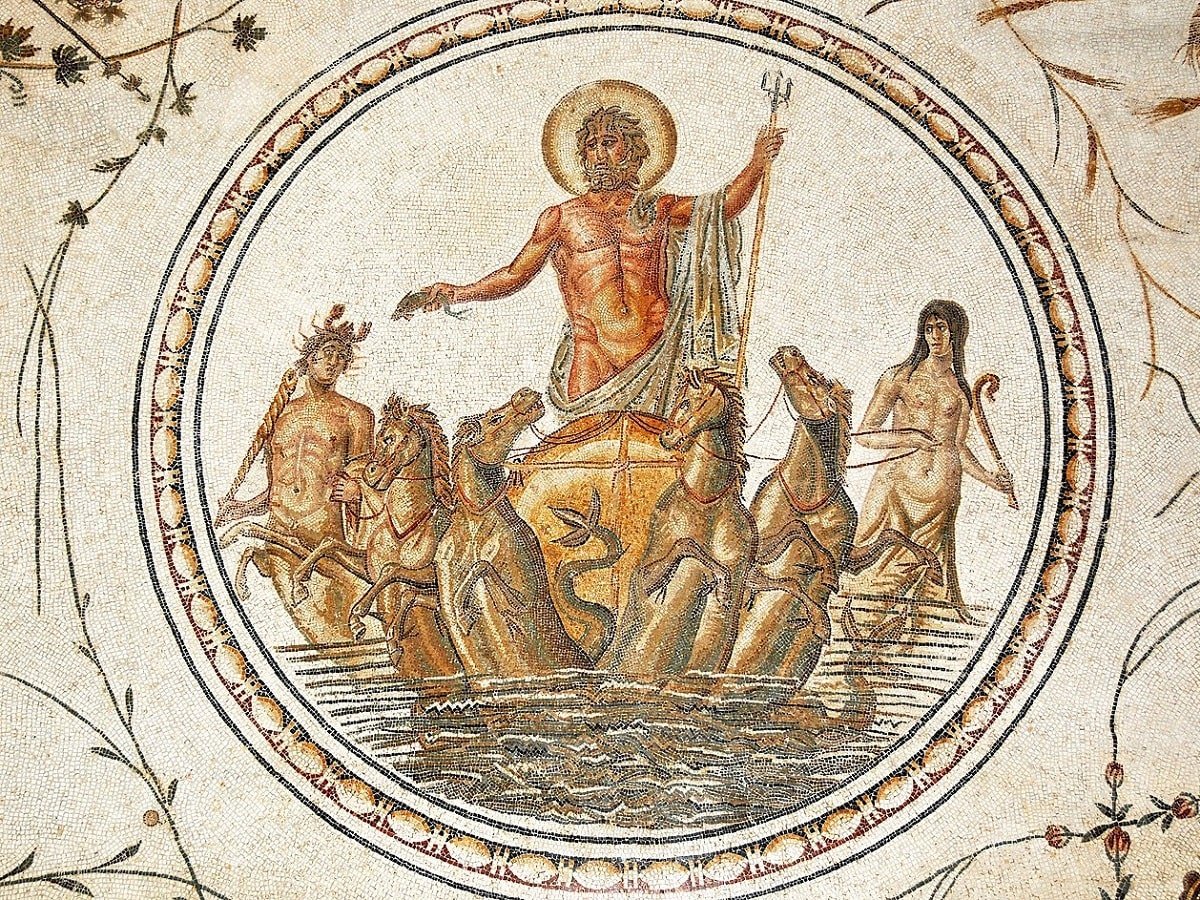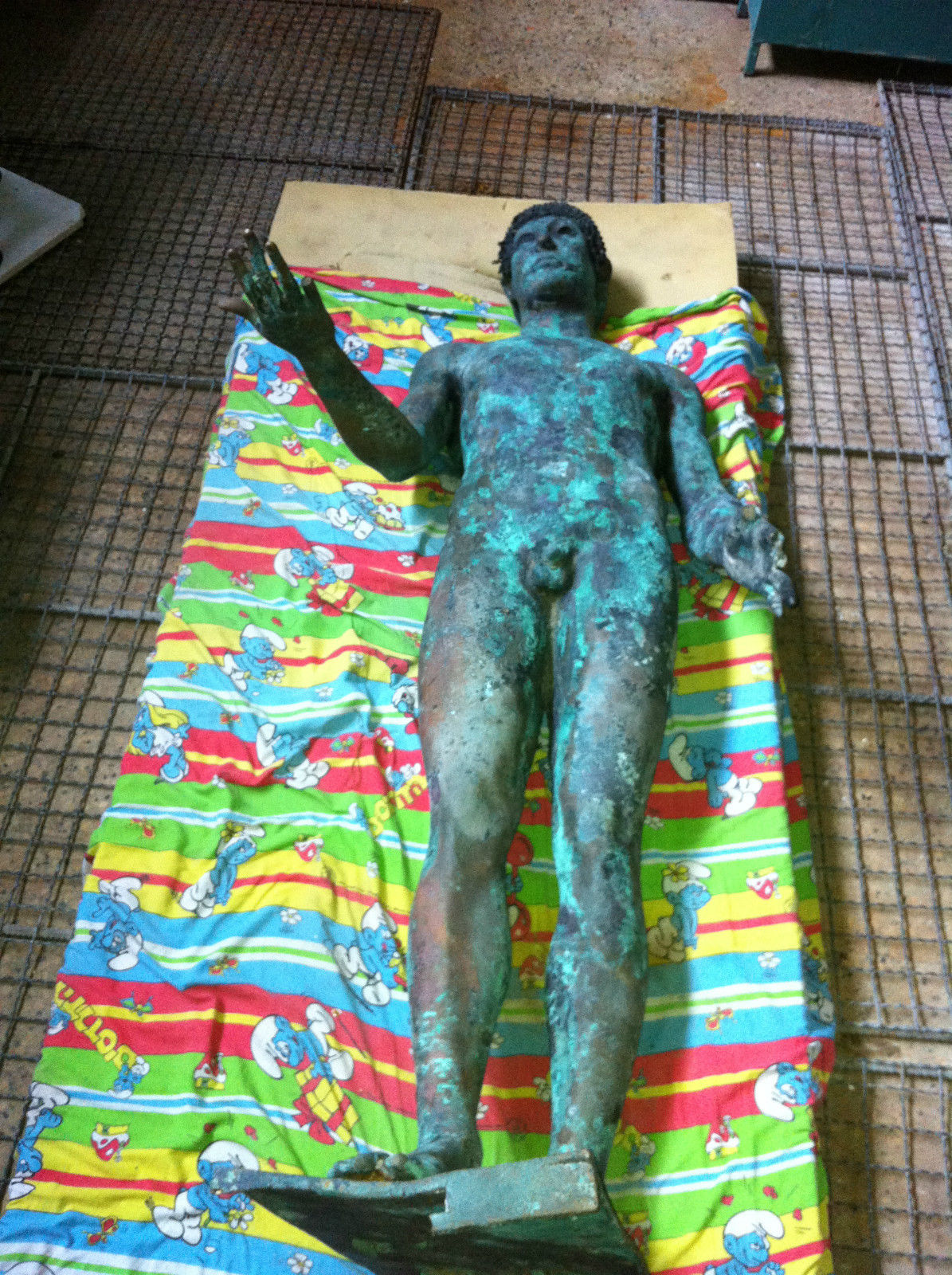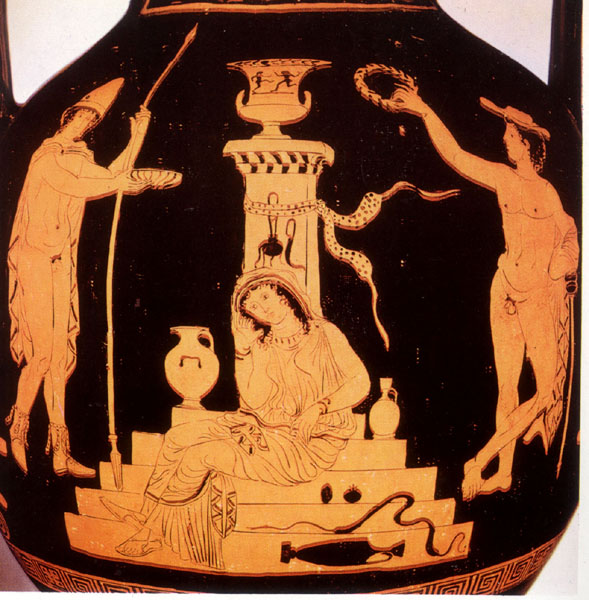Absolutely correct. Here is archaeological evidence of Herakles in Helios' Krater; these are all variants of a similar myth. In this myth, Herakles is basically 'divinized' by riding in the Chalkeion/Krater of Helios. As Herodotus noted, Khonsu-Who-Is-Ever-Young is Herakles: the Wandering God/Phoenican Warrior who slew Seth. But he was also affiliated with Healing, which brings us back to the Libyan myth.billd89 wrote: ↑Mon Oct 16, 2023 9:59 am Besides the Tripod Cauldron discussed above, an alternate or parallel reading is available:οὗτος γὰρ χάλκειον ἐς οὐρανὸν ἐστήρικται = "For this Chalkeion {brazen shield?} is firmly set in Heaven"
[...]
In a myth complex w. frescos illustrating Herakles, this seems relevant. It is the image of a Chalkeion held by two tritons (i.e. ichthyocentaurs) in the recently discovered Tomb of Cerebus near Naples, IT:
Is it perhaps Poseidon's Chalkeion?Statius, Thebaid 1. 55 ff (trans. Mozley) (Roman epic c.1st A.D.) :
"[In the train of Neptune-Poseidon] the winds and tempest are silent and with tranquil song proceed the Tritones (Tritons) who bear his armour...
On the other hand, could this be the four-horse team Chariot of Helios in the Cauldron crossing the Ocean at night (PEG F 7 = F 4 D. = F 11 W.)?
Triumph of Neptune Mosaic from Utique, Tunisia, c.150 AD:
In frescos illustrating Herakles, we recall that Amphitryon's brazen shield was -- in one myth -- the cradle of baby Herakles. In another myth, Herakles fought Nereus, a Triton who may have held/owned Neptune's Shield. And Herakles would take Helios Geryon's cauldron to cross the Ocean. (There were yet other myths about the Shield of Ares/Mars, perhaps conflated here?)
Triton or Nereus
The written myths show Heracles fighting a metamorphosing sea god called "the Old Man of the Sea." The scenes look a lot like this one of Heracles fighting Triton. A note for those researching further: The Greek for the name "Old Man of the Sea" is "Helios Geryon." In the Iliad, 'The Old Man of the Sea' is the father of the Nereids. Although not named, that would be Nereus. In the Odyssey, 'The Old Man of the Sea' refers to Nereus, Proteus, and Phorkys. Hesiod identifies 'The Old Man of the Sea' with Nereus alone.
(ll. 233-239) And Okeanos begat Nereus, the eldest of his children, who is true and lies not: and men call him 'The Old Man' because he is trusty and gentle and does not forget the laws of righteousness, but thinks just and kindly thoughts.
Theogony, Translated by Evelyn-White
Helios Geryon has a Magical Cup which doubles as a Divine Boat! This must allude to a brass cauldron or krater with mystical meaning; Tsagalis (2022, p.163) provides a foundational literary summary to this part of the Herakles myth:Mimnermos (fr. 12.5–10 IEG) {c.340 BC} is another early authority (but later than Peisandros {c.640 BC}). D'Alessio (2014, 91–2) has suggested that the choice of the cauldron by Eumelus Corinthius {c.740 BC} may have had a specific mythological connotation, pointing to the Sun's 'rebirth' or 'rejuvenation' the next day, as is the case with similar uses of the cauldron in the Archaic and early Classical Period. For Indo-European parallels, see West (2007) 203–7; on Eumelus, Titanomachy Fragment 12 EGEF, see Tsagalis (2017) 70–3. The first (certain) author who reports that Herakles sailed across the Okeanos by Helios cauldron is Agatharchides of Knidos {c.150 BC} (in Phot. Bibl. 443a [VII 139.37–8 Henry]), followed by Alexandros of Ephesos {75 BC} (fr. 38 SH). D'Alessio (2014, 91) interprets the use of a cauldron {=λέβης, common term for 'pot' or basin} (instead of a cup or bowl) as 'rationalistic' and cites Euphorion {c.200 BC}(fr. 52 CA = 72 Lightfoot), who mentions a bronze light-vessel (ἄκατος), toying with the word's secondary meaning of 'boat-shaped cup'. 394 Finglass (2021, 136) maintains that the use of Helios' bowl by Herakles stressed the 'greatness of his achievement'. He also argues that several details of this episode found in later sources may have originated from Peisandros' narrative.
None of this contradicts the (Jewish) Biblical understanding of the Chalkeion as a brass/copper cauldron (בַקַּלַּ֙חַת֙ = kettle): see 1 Samuel 2:14, Chronicles 35:13, Job 41:31. But where Orphic Fragment 1094 Fr. 377 F (245 K.), 17-18 may indicate a pre-1st C. BC Judaized poem, so similar Jewish representations of the Demiurge as a Charioteer/Pilot are especially fascinating. Indeed, several Israeli synagogue mosaics of the Roman Period point to a definite Jewish interpretation of the Demiurge as Helios riding such a shield.
[...]
Chips [1913], p.37:
Chonsu, or Chonsu-Nefer-Hotep, the child of the sun god Ammon, often spoken of as the Herakles of the Egyptians, was regarded as a medicine god. Tiele, the (1882) Egyptologist, says: "He was resorted to for the cure of all diseases or for the excorcism of all the evil spirits who inflict them."
J.G. Milne, “Greek Inscriptions from Egypt,” Journal of Hellenic Studies [1901], p.283:
The dedication to Hermes-Herakles now under consideration is explained by this process. In pure Greek theology, there obviously could be no connection between these gods. But in the Graeco-Egyptian fusion, Hermes represented Thoth, and Herakles Khonsu. Thoth and Khonsu were both lunar gods, and therefore easily identified and the fact of their identification in the district about Pathyris and Hermonthis is testified by the occurrence of the proper name Khonsthout, which is found in Greek papyrii and also, Mr. Griffith informs me, in demotic. So the Greeks of Pathyris worshipped Thoth-Khonsu as Hermes-Herakles.
See Herakles, with a leonté, bow and claw, pilots an enormous krater or deinos (bowl).
Vulci, Papal Government - Vincenzo Campanari excavations, 1835-1837; c. 480 B.C. Cat. 16563:

Attic Pitcher (olpe) with Herakles in the Bowl of Helios. MFA Bsoton, 03.783, c.515 BC. :



